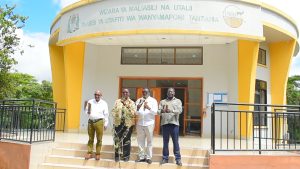TAWIRI Tarangire elephant Project managed 29 families of the Tarangire northern elephant sub-population. Fifty-five (55) births were recorded making the total population of females and males under the age of 10 years in the long-term database reaching 1,088 individuals. The field survey exposed a general presence of many elephants’ herds estimated at 26 families found inside the park, two (2) outside the park and one family herd were not seen during field monitoring. The presence of recognised individual elephants enables the project field team to easily to follow-up these groups, however, most were rarely seen more than three to five times. There was no deaths incidence recorded among all age categories. Many herds were observed to be accompanied by their newly born calves. Additionally, the project has continued to monitor a mother named Sakina with twin calves (a very rare/special observation) that belong to the group S family. In Cedric and Cliff, now more than ten years of age, thus, have left their natal herds. Jaribu and Vikapu have turned ten years and have also started to isolating themselves by staying on the peripherals of their natal herds. There are now 16 elephants over 55 in the population and five 60 years or older. The steady maturing of the Tarangire elephant population has been a key feature of the study since it began, making a model of a ‘normal’ or ‘unpoached’ elephant population across savanna areas in Africa. Also, Human Elephant Conflict (HEC) mitigation training workshops to about 200 community members (ToT) were conducted in Monduli, Babati, Same and Mwanga Districts.
- Category : Projects
- Posted on: August 15, 2023








 Users Today : 2
Users Today : 2 Users Last 7 days : 513
Users Last 7 days : 513 Users This Month : 77
Users This Month : 77 Total Users : 46397
Total Users : 46397